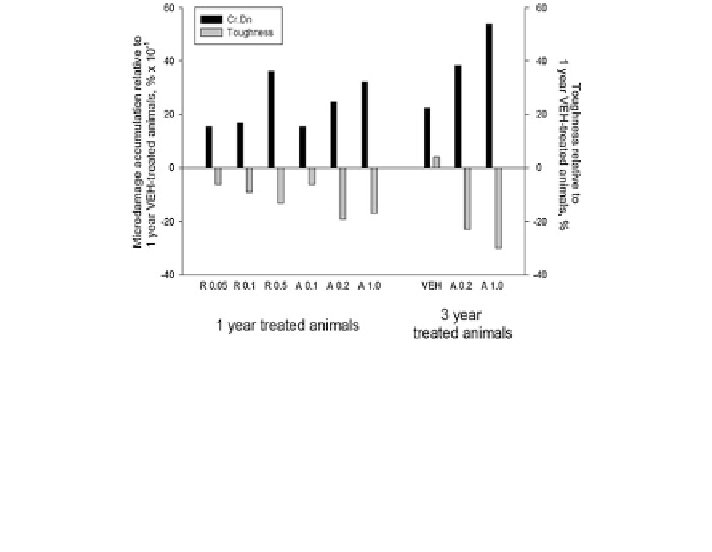Biomedical Engineering Reference
In-Depth Information
Fig. 5 Discordant changes in microdamage accumulation and vertebral toughness following one
or 3 years of bisphosphonate treatment in beagle dogs. Following one year of treatment with
various doses of daily oral risedronate (R) or alendronate (A), vertebral microdamage was
significantly higher compared to vehicle (VEH). In these same animals, toughness was
consistently lower in all bisphosphonate-treated groups. In animals treated with A or VEH for
3 years, microdamage was significantly higher in all groups compared to 1 year VEH animals yet
toughness was only reduced in the A-treated groups. These data clearly illustrate that increases in
microdamage are not universally associated with reductions in toughness, but that bisphosphonate
treatment is likely the key factor associated with reductions in toughness
showing that non-BP treated animals that have an age-related 2-fold increase in
microdamage accumulation had no change in bone toughness [
55
] (Fig.
5
). Thus
the current theory is that microdamage accumulation with BPs is more likely the
consequence of the increased brittleness and reduced toughness, and not the cause
of it. AGEs naturally accumulate in bone as it ages, but under normal rates of bone
turnover, they are prevented from accumulating to high levels. However, when
bone turnover is suppressed, they can accumulate and make it more likely for
cracks to initiate.
5 The Mechanism of Action of Recombinant
Human Parathyroid Hormone (1-34)
Recombinant human parathyroid hormone [rhPTH (1-34), or teriparatide] is the
only anabolic agent for bone approved for use in humans. Another analogue of
PTH (PTH-1-84) has also been developed for treatment of osteoporosis. This drug
is currently approved in Europe, but not in the U.S. because its effect on bone was
essentially similar to that of teriparatide, and studies did not demonstrate superi-
ority [
87
-
89
].

Search WWH ::

Custom Search